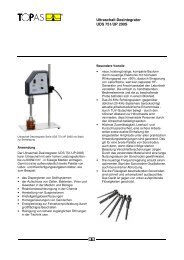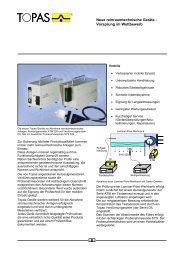Test Rigs for Cleanable Air Filter Media Series AFC ... - TOPAS GmbH
Test Rigs for Cleanable Air Filter Media Series AFC ... - TOPAS GmbH
Test Rigs for Cleanable Air Filter Media Series AFC ... - TOPAS GmbH
Create successful ePaper yourself
Turn your PDF publications into a flip-book with our unique Google optimized e-Paper software.
<strong>Filter</strong> test rig <strong>AFC</strong> 131 according to VDI 3926 Part 1, version 2<br />
<strong>Test</strong>ing of <strong>Filter</strong> <strong>Media</strong> …<br />
is important <strong>for</strong> both the development and<br />
optimization of filter materials, as well as <strong>for</strong> quality<br />
assurance during the production process. The<br />
most interesting features <strong>for</strong> the characterization of<br />
cleanable filter media are:<br />
• Curve of pressure drop,<br />
• Curve of residual pressure drop,<br />
• Fractional efficiency,<br />
• Gravimetric separation efficiency,<br />
• Dust penetration through the filter medium,<br />
• Loading capacity of the filter.<br />
Topas has developed its filter testing systems of<br />
series <strong>AFC</strong> <strong>for</strong> the determination of this<br />
standardized per<strong>for</strong>mance parameters. This test<br />
equipment allows testing of specific filter media <strong>for</strong><br />
cleanable filters <strong>for</strong> dust removal from industrial<br />
flue gases and the recovery of valuable materials<br />
(bag/tube filters, cartridge filters or pocket filters) in<br />
accordance with international standards. The<br />
design of the <strong>AFC</strong> test 131 is based on the<br />
VDI 3926 Part 1, Version 2 and of the <strong>AFC</strong> 133<br />
according to the new ISO 11057:2011. The<br />
ISO 11057 is based on the VDI 3926, ASTM<br />
D6830-02 and the JIS Z 8909-1. These test rigs<br />
can also implement a customized filter media<br />
check with individual tests and configurable workflows.<br />
The control software runs under Windows<br />
<strong>Test</strong> <strong>Rigs</strong> <strong>for</strong> <strong>Cleanable</strong> <strong>Air</strong> <strong>Filter</strong> <strong>Media</strong><br />
<strong>Series</strong> <strong>AFC</strong> 131 acc. to VDI 3926 (Type 2)<br />
<strong>Series</strong> <strong>AFC</strong> 133 acc. to ISO 11057<br />
and was developed by Topas. It ensures easy<br />
operation of the test rig and the implementation of<br />
accurate, repeatable and traceable testing.<br />
Special Advantages<br />
• Possible use of various aerosols<br />
(Solid aerosols and droplet aerosols)<br />
• Standardized testing of filters with aluminium<br />
oxide (e. g. Pural NF)<br />
• Fully automatic test sequence over 14 hours<br />
without user intervention<br />
• Flexible design allows <strong>for</strong> quick modifications<br />
and future expansion<br />
• User-friendly control software PAFWin<br />
• Excellent component matching by combining<br />
Topas devices<br />
Applications<br />
• <strong>Filter</strong> tests <strong>for</strong> cleanable filter media according<br />
to ISO 11 057 and VDI 3926<br />
• <strong>Filter</strong> tests based on other standards<br />
- <strong>Air</strong> filters <strong>for</strong> air conditioning systems<br />
according to EN 779<br />
- <strong>Air</strong> filters <strong>for</strong> motor vehicles according to<br />
DIN 71460-1 / ISO/TS 11155-1<br />
- Motor intake filters according to ISO 5011<br />
• Development and optimization of filter media<br />
according to internal company standards of the<br />
user<br />
• Quality assurance in production<br />
<strong>Filter</strong> test rig <strong>AFC</strong> 133 per<br />
as ISO 11057, VDI 3926<br />
Part 1, version 1
PIC<br />
Ambient air<br />
inlet<br />
Dust disperser SAG<br />
<strong>Test</strong> channel<br />
PDIRS+<br />
<strong>Test</strong> filter<br />
Sampling ports <strong>for</strong> optical<br />
particle counter<br />
Pressure vessel<br />
TIR MIR<br />
Schematic of the VDI 3926-A2 filter test rig <strong>AFC</strong> 131<br />
Dust feeder<br />
and balance<br />
Inspection<br />
window<br />
Raw gas inlet<br />
Rectangular raw gas channel<br />
Photometric concentration monitoring<br />
<strong>Filter</strong> holder and testfilter ø140mm<br />
Cylindrical<br />
clean gas channel<br />
Dust recipient<br />
Pressure vessel<br />
Volume flow control<br />
Compressed<br />
air<br />
PIC<br />
Absolute filter<br />
Volume flow control<br />
and recording<br />
Absolute filter<br />
Raw gas filter<br />
Clean gas extraction<br />
Raw gas extraction<br />
Schematic of the ISO 11057 filter test rig <strong>AFC</strong> 133<br />
<strong>AFC</strong> test rigs consist essentially of the test channel<br />
with the test filter holder, the flow unit, the dust<br />
feeder <strong>for</strong> solid aerosol generation, the optical<br />
particle measuring device and a cleaning unit. In<br />
accordance with the normative requirements, the<br />
clean gas channel in the <strong>AFC</strong> 133 is connected<br />
horizontally to the vertical raw gas channel. In<br />
addition, the dust feed is controlled gravimetrically.<br />
Furthermore, the inlet concentration is monitored<br />
photometrically. In the area of the test filter there is<br />
a window in the raw gas channel.<br />
Basic Design<br />
<strong>Test</strong>s of <strong>Cleanable</strong> <strong>Filter</strong>s<br />
This test is conducted in accordance with VDI 3926<br />
and ISO 11057. The continuous dust loading of the<br />
test filter leads to a steadily increasing pressure<br />
drop. When a defined pressure difference across<br />
the test filter is reached, the filter cake is cleaned<br />
periodically with a pressure pulse (pulsejet).<br />
The pressure drop falls down to a residual<br />
pressure loss value, which is due to irreversibly<br />
stored or deposited particles. During the cleaning<br />
process the particle concentration in clean gas<br />
increases <strong>for</strong> a short time.<br />
The cleaning unit consists of a pressure tank, a<br />
fast opening and closing solenoid valve (pressure<br />
pulse time is 50 to 200 ms) and a blowpipe with a<br />
nozzle diameter of 3 mm.<br />
Typical test result <strong>for</strong> a cleanable filter: left side - temporal<br />
differential pressure drop, right side - the curves of the cycle<br />
times (blue) and the residual pressure drop (red)<br />
<strong>Filter</strong> Holder<br />
The test filter medium is clamped into a special<br />
filter holder which ensures the secure and tight fit<br />
of the filter medium during testing.<br />
With a few simple steps, the filter holder is<br />
removed from the test channel to change the filter<br />
medium and to determine its mass. A supporting<br />
grid prevents severe de<strong>for</strong>mation of the filter<br />
medium at high flow rates.<br />
Also, the filter (absolute filter) which is downstream<br />
of the test filter medium can easily be installed and<br />
removed <strong>for</strong> weighing.
Separation Efficiency of <strong>Filter</strong>s<br />
The backup filter (absolute filter) of 40 mm freeflowed<br />
diameter downstream of the test filter is<br />
needed to determine the mass of particles in the<br />
clean gas. The test filter has a free-flowed diameter<br />
of 140 mm. By weighing these two filters (test filter<br />
and backup filter), the total separation efficiency of<br />
the medium is determined gravimetrically. For this<br />
task, scales that have at least the required<br />
accuracy of 0.01 g (test filter) and 0.01 mg (backup<br />
filter) should be used, according to the<br />
requirements mentioned in the standard.<br />
The design of the test channel allows <strong>for</strong> easy<br />
installation and removal of the test and backup<br />
filter.<br />
Dust Loading <strong>Test</strong>s<br />
Dusting tests can be done on the test rigs of the<br />
series <strong>AFC</strong> as well. Here, the differential pressure<br />
increase is determined as a function of the<br />
deposited dust mass. Due to scale-up statements<br />
on the filter testing are possible, according to the<br />
test standards EN 779, DIN 71460-1,<br />
ISO/TS 11155-1 and ISO 5011.<br />
Software window with representation of loading capacity of a<br />
dust loading test<br />
<strong>Filter</strong> <strong>Test</strong>s<br />
Fractional Separation Efficiency of <strong>Filter</strong>s<br />
Software window showing fractional separation efficiencies<br />
The fractional separation efficiency is determined<br />
using a laser aerosol spectrometer LAP 322 in a<br />
particle size range of 0.2 to 40 microns. The<br />
sampling can be controlled by switching between<br />
raw gas sampling, purge and clean gas sampling.<br />
Thus, only one single particle analyzer is required.<br />
The switching times of the controller are set freely<br />
by the user. If desired, a Topas dilution system<br />
DIL 55x or and a particle counter LAP 340 may be<br />
delivered separately.<br />
Effective measurement<br />
of particle size<br />
distributions with a laser<br />
aerosol particle size<br />
spectrometer LAP 322<br />
(arrangement with<br />
sample switching unit<br />
below the test channel)
Control Software PAFWin<br />
The control software PAFWin used <strong>for</strong> test rigs has<br />
been developed by Topas. This Windows<br />
compatible software takes over complete control of<br />
the test rig, data acquisition and data processing.<br />
The test sequence is per<strong>for</strong>med automatically, but<br />
can also be controlled by the user manually.<br />
Further advantages of PAFWin are:<br />
• Automatic test sequences according to the<br />
selected test standard<br />
• Manual control <strong>for</strong> calibration, service and<br />
research<br />
• Data output and data acquisition <strong>for</strong> long-term<br />
studies<br />
• Database system <strong>for</strong> filter samples, test results<br />
and test material systems<br />
Data presentation and statistical calculations<br />
• Data transfer via the clipboard and Dynamic<br />
Data Exchange to Excel<br />
PAFWin test rig <strong>AFC</strong> 133 visualization<br />
The fractional efficiency and particle size<br />
distribution can be determined separately, stored<br />
and printed. The user is in<strong>for</strong>med and guided<br />
through the test using a special instruction and<br />
display window. User-defined test procedures are<br />
available on request.<br />
Topas <strong>GmbH</strong><br />
Technologie-orientierte<br />
Partikel-, Analysen- und Sensortechnik<br />
Oskar-Röder-Str. 12 · D-01237 Dresden<br />
Control Software and<br />
Specifications<br />
Specifications<br />
Phone +49(351)216643-0<br />
Fax +49 (351) 21 66 43 55<br />
E-mail office@topas-gmbh.de<br />
Internet www.topas-gmbh.de<br />
<strong>AFC</strong> 131 <strong>AFC</strong> 133<br />
Volume flow rate 2 ... 40 m³/h 0.5 ... 5 m³/h<br />
<strong>Filter</strong> cross<br />
section<br />
176 cm²<br />
(∅150 mm)<br />
154 cm²<br />
(∅140 mm)<br />
Face velocity 0.05 ... 0.6 m/s 0.5 ... 5 m/min<br />
Differential<br />
pressure<br />
0 ... 2000 Pa<br />
Climate sensors Temperature, relative<br />
humidity, air pressure<br />
Pressure vessel 0.2 ... 0.6 MPa<br />
Pressure pulse<br />
time<br />
50 ... 200 ms<br />
Aerosols Dusts: Pural NF, Pural SB,<br />
ISO 12103-2;<br />
with Dust Disperser SAG 410<br />
Droplets: DEHS, PAO salt<br />
aerosols, PSL<br />
with Atomizer Aerosol<br />
Generator ATM 220<br />
Aerosol<br />
Spectrometer<br />
LAP 322,<br />
0.2...40 µm<br />




